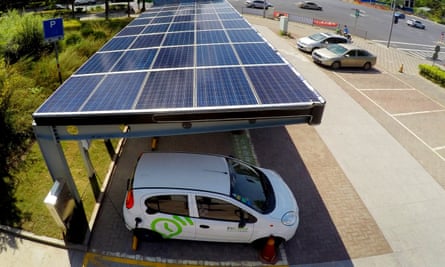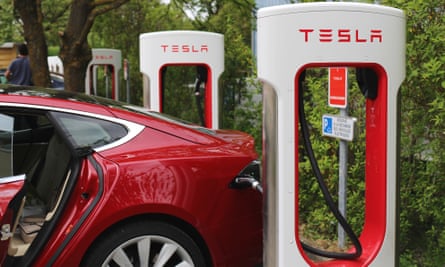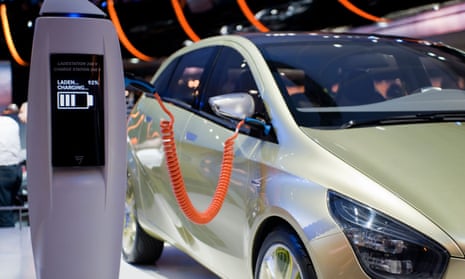Jorge Cruz has just finished his overnight shift stacking shelves at Whole Foods in Los Altos, California, and is waiting at the bus stop outside. Like much of Silicon Valley, there’s a regular flow of Tesla, BMW, Nissan and Google electric cars that cruise past from their nearby headquarters, and Cruz rather likes them.
“I really wouldn’t mind having an electric car,” he says, though his first choice is probably a Honda or an Acura. Regardless, for now, he rides the bus. “I need to save up for a car,” he explains.
As Cruz waits, a newly purchased Tesla zips by, advertising “ZERO EMISSIONS” on its license plate.
Electric cars have never been closer to the mainstream, the market pushed ahead by California subsidies for electric car buyers, and a wide array of new models from established car firms such as Toyota and Chevy. Tesla’s focus on luxury, high-performance vehicles has also broadened their appeal; electric cars are no longer purely an environmental statement, but a tech status symbol too.
Yet the “zero emissions” claim grates on some experts, who have continued to argue over whether electric cars are really more environmentally friendly than gas guzzlers, once the manufacturing process for the vehicles and their batteries are taken into account.
Electric cars rely on regular charging from the local electricity network. The power plants providing that energy aren’t emission-free; even in California, 60% of electricity came from burning fossil fuels in 2015, while solar and wind together made up less than 14%.
“I couldn’t bear to hear them say the words ‘zero emissions vehicle’ one more time,” says Joshua Graff Zivin, who advised one of California’s three main utilities, San Diego Gas & Electric, on electric cars. Graff Zivin is a professor of economics and public policy at the University of California, San Diego.
“How you incentivize them to charge could really matter,” Zivin says about electric vehicle owners. “Utilities haven’t thought through it.”
One third of US power is generated by coal
More than 1.2m electric vehicles were sold in 2015, the intergovernmental group International Energy Agency estimates, while campaign group Transport & Environment expects 2m electric vehicles to be on the road by the end of 2016. The world’s biggest markets for electric cars are the United States and China, though electric vehicles have a larger market share in some European countries such as the Netherlands and Norway.
California’s electric vehicles can plug into a greener grid than most regions of the world – especially China, where coal generated 72% of all power in 2014 according to the International Energy Agency (IEA). The US gets about a third of its electricity from coal-fired power, IEA says, and more than 40% of total electricity worldwide comes from burning coal.

In the US, the Union of Concerned Scientists – which works to raise awareness of climate change – believes that despite a fossil-fuel-dependent grid, electric cars are, on balance, better for the environment.
“There are no areas of the country where electric vehicles have higher global warming emissions than the average new gasoline vehicle,” the campaign group claims in its paper, State of Charge, which calculates the emissions equivalent of an electric vehicle using the makeup of the local energy supply. Using UCS’s formula, a Tesla Model X charging in the Los Altos Whole Foods garage achieves a fuel efficiency equivalent to 81 miles per gallon – far higher than a gas-powered car.
Yet not all scientists agree with that approach. “All of the action is in the hourly,” says Graff Zivin. It’s not only the region that an electric vehicle plugs into that matters. The hour of the day is equally critical. “The cheapest power is not the greenest power.”
In California, the cheapest power is produced at night, mostly from natural gas, hydroelectric dams and nuclear. Night is when many people will charge their electric cars. However, the greenest power gets generated during the day, when solar power can feed the grid; solar doesn’t work in the dark, windmills stop spinning if there’s no wind and, in today’s grid, there is almost no capacity to store solar and wind-generated electricity to use later. Grid storage is slowly expanding, but most electricity has to be used as it is produced.
Units of electricity also can’t be tagged according to where and how they were generated, so nobody can verify whether the electricity they use is from a sustainable source – unless they plug directly into their own solar panel or windmill.
Electric car use improves air quality in cities
Graff Zivin, along with economics researchers Matthew Kotchen and Erin Mansur, waded into this contentious territory in a 2014 paper. Zivin concluded that a plug-in electric vehicle, such as the Nissan Leaf, always produces less carbon dioxide emissions than a hybrid electric- and gas-powered car – but only in selected regions that rely on less coal, like the western United States and Texas. Charging from the coal-dependent grid in the upper midwest of the US at night could generate more emissions than an average gasoline car. And, in some US regions, plugging in at different times of day could even double an electric car’s emissions impact.
Charging an electric car for 100 miles of travel could use about 30kwh – roughly the same amount of energy an average US home uses in just over a day.
“Since we wrote this paper we have seen more and more coal going out [of use],” Zivin says. Natural gas-fired power plants emit less greenhouse gas per unit of energy produced than coal-fired power stations. As more coal plants are mothballed – partly in response to cheaper natural gas prices – so the electricity powering electric cars emits less carbon dioxide. “But the counter to that is that because of [Barack] Obama’s Cafe standards, we now have much cleaner gasoline cars.”
Nobody knows what President-elect Donald Trump will do with Cafe, the Corporate Average Fuel Economy standards, which regulate fuel economy and emissions on new US vehicles. Yet whatever happens in the US probably won’t hold back the adoption of electric vehicles worldwide, because apart from limiting carbon dioxide emissions, electric cars can also improve the local air quality in cities by moving emissions from cars to power plants.

“Even conservative people in Los Angeles are interested in air quality,” says Thomas Turrentine, director of the Plug-in Hybrid & Electric Vehicle Research Center at the University of California, Davis. He has surveyed electric vehicle owners worldwide about why they like their electric cars. “Climate change was not on the top of the list.”
While carbon dioxide is a greenhouse gas, it isn’t toxic to human health and does not contribute to smoggy skies. However, gasoline and diesel cars also emit nitrogen and sulfur compounds that contribute to acid rain and form tiny airborne particles that spoil air quality and contribute to strokes, heart disease, lung cancer and respiratory diseases, including asthma. Air pollution is one of the world’s most urgent environmental hazards, causing more than 3m premature deaths annually, according to the World Health Organization. The Chinese government has repeatedly announced its commitment to develop electric vehicles, partly because of air pollution concerns.
Governments are incentivizing adoption
Spurred by Volkswagen’s 2015 emissions scandal, in which the company falsified its diesel emissions levels during testing, Germany passed a resolution in October banning combustion engine cars by 2030. It’s a largely symbolic regulation, designed to spur action in the European Union, but the Netherlands and Norway are also discussing bans, and 20% of new car sales in Norway are already electric.
For some people, though, giving up gasoline will be hard. “If the whole world started going to electric vehicles, and the demand for gasoline substantially dropped, the price of oil would plummet,” says Severin Borenstein, professor of business administration and public policy at the Haas School of Business at the University of California, Berkeley. If oil demand drops by 10%-20%, Borenstein says, the price would “almost certainly collapse” to $20 per barrel or lower, or $1 per gallon gasoline before taxes. “That would make it much less economic to use electric vehicles – that would be where we really run into the real question: are we willing to stick to this?”

Another challenge is the material used in electric cars’ lithium batteries. “The positive side is they’re not particularly toxic,” Turrentine explains, unlike lead or nickel-based batteries, but they can still be difficult to recycle. Batteries can also use rare elements such as cobalt, the mining of which has raised some serious environmental and ethical issues in countries such as the Democratic Republic of Congo. Battery technology may become less dependent on such elements, Turrentine believes, though it is still some way off.
But in California, the government is pushing ahead with the electric vehicle revolution. Consumers have been offered generous clean air incentives of up to $2,500 per vehicle, and the US government also offers a $7,500 tax credit on electric cars.
While Silicon Valley’s technology companies are pioneering electric cars as part of their self-driving car vision, the California Energy Commission has handed out $150m in grants for building out electric charging infrastructure, and another $10m grant went to Tesla for its development of the Model X.
Back at Whole Foods – where an $88,000 Tesla is charging up – even the charging stations were paid for with public money. When Cruz hears that, he’s a little less enthusiastic about the electric car future.
“If I would have known that, it’s like, well, what do I get?” he says. “I’d rather use the money for those who commute from here to there on the bus.”
- This article was amended on 9 December 2016 to clarify that there is almost no capacity to store solar and wind-generated electricity to use later.

Comments (…)
Sign in or create your Guardian account to join the discussion